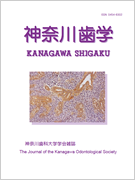- HOME
- > 一般の方
- > バックナンバー:神奈川歯学
- > 21巻3号
- > アブストラクト
アブストラクト(21巻3号:神奈川歯学)

Japanese
| Title : | 第三大臼歯に関する放射線学的研究 |
|---|---|
| Subtitle : | 原著 |
| Authors : | 松尾洋一郎, 東与光 |
| Authors(kana) : | |
| Organization : | 神奈川歯科大学放射線学教室 |
| Journal : | 神奈川歯学 |
| Volume : | 21 |
| Number : | 3 |
| Page : | 303-331 |
| Year/Month : | 1986 / 12 |
| Article : | 原著 |
| Publisher : | 神奈川歯科大学学会 |
| Abstract : | 「I. はじめに」第三大臼歯 (以下, 智歯という) に関する研究はきわめて多く, 基礎的あるいは臨床的にも多くの検討が行われてきた. たとえば, 基礎的には, 智歯の発生・発育あるいは形態について報告がなされている. また, 臨床的には主に歯科矯正学や口腔外科学の立場から多くの研究が報告されている. その代表的な報告として, 智歯の植立状態を分類して各分類ごとの抜歯方法について検討した報告がある. このような分類はWinterが最初に報告し, その後, PellとGregoryがこのWinterの分類をもとに, さらに詳細な分類について報告している. しかし, このような確立した分類があるにもかかわらず, これまでの研究では, たんなる単一の分類項目に関したものであった. また, 従来の智歯のX線学的な研究は, 口内法撮影もしくは下顎骨骨体撮影によるものであった. そこで, 著者は, 神奈川歯科大学および日本女子衛生短期大学の学生の臨床実習中に撮影したパノラマ断層X線像について, 智歯のX線学的研究を行った. |
| Practice : | 歯科学 |
| Keywords : | 第三大臼歯, 萌出角度, 埋伏歯 |
English
| Title : | Radiographic Studies on the Third Molars |
|---|---|
| Subtitle : | |
| Authors : | Yoichiro MATSUO, Tomomitsu Higashi |
| Authors(kana) : | |
| Organization : | Department of Radiology Kanagawa Dental College |
| Journal : | Kanagawa Shigaku |
| Volume : | 21 |
| Number : | 3 |
| Page : | 303-331 |
| Year/Month : | 1986 / 12 |
| Article : | Original article |
| Publisher : | Kanagawa Odontological Society |
| Abstract : | [Abstract] : The purpose of this study was to observe the present status of the third molars in japanese students using panoramic radiograms. The results were summarized as follows. 1. The frequency of occurrence of congenital missing of the maxillary and mandibular third molars in the males of the present study was found almost the same as that of the reports after 1936, but that in the females was lower than that of the previous reports. 2. The condition by quadrants of the dental arches was classified into two types : normal and abnormal. 3. For graphic distribution of the angulation of maxillary third molars, there was a difference between the normal and the abnormal. 4. The angulation of mandibular third mlors showed a distribution with two peaks. 5. The group of which showed the highest frequency was Class I position 1 vertical in the mandibular third molars. However, there was a significant difference in the frequency between the normal and the abnormal. 6. The space for mandibular third molars in the females was significantly wider than that in the males. 7. The incidence of impacted third molars were more common in the normal type than that in the abnormal type. 8. The incidence of the maxillary third molars impacted in the bone with an abnormal pericoronal space of 3 mm wide or greater was higher than that in the previous reports. |
| Practice : | Dentistry |
| Keywords : |
